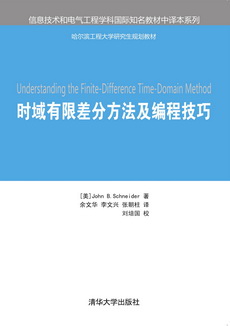





定价:69元
印次:1-3
ISBN:9787302377719
出版日期:2015.03.01
印刷日期:2018.11.05
图书责编:文怡
图书分类:零售
《时域有限差分方法及编程技巧》是一部详细介绍时域有限差分方法、编程技巧和应用的著作。该书深入浅出地介绍了时域有限差分基本理论、关键技术、编程技巧以及工程应用。该书配有一维、二维和三维时域有限差分原程序并详细地解释了编程方法和技巧。 该书非常适合研究生和年轻教师用作计算电磁学教材以及科学研究或者工程应用的参考书。
译者序 华盛顿州立大学 John Schneider教授的《 Understanding Finite Di.erence Time Domain Method》是一本非常难得的计算电磁学入门的优秀教材。该书除了由简到繁系统地介绍时域有限差分理论和方法外,从软件工程的角度结合理论和方法,指导学生一步一步编写一个优秀的时域有限差分应用程序,使学生得到了时域有限差分方法和软件工程两方面的学习和训练。该书经过在哈尔滨工程大学电磁场与微波专业的教学与实践,得到了学生广泛好评,取得了良好的教学效果。 参加该书翻译的有哈尔滨工程大学余文华、李文兴、张朝柱、段瀚林、孙照清、李千、卓庆坤、王美玉、张文、刘鑫博、郭晓亮、田春胜、赵月明、刘玉敬、张兰超、孔媛媛、曹小东。该书由国防科技大学刘培国教授校对。 该书适合作为电磁场与微波技术专业高年级本科生和研究生的教材或参考书,也可以作为年轻教师和工程师的参考书。该书为哈尔滨工程大学研究生规划教材。 余文华于哈尔滨工程大学 致中国读者 This book grew out of a set of notes I prepared for a graduate-level course on the .nite-di.erence time-domain (FDTD) method I taught at Washington State University. The notes were intended to supplement the textbook I used for the course, Computational Ele...
1.1引言 ............................. 1
1.2有限精确度 .......................... 1
1.3符号处理 ........................... 5
第 2章电磁学的简要回顾 ........................ 6
2.1引言 ............................. 6
2.2库仑定律和电场强度 ....................... 6
2.3电位移矢量 .......................... 7
2.4静电场 ............................ 9
2.5梯度、散度和旋度 ........................ 10
2.6拉普拉斯运算 ......................... 12
2.7高斯定理和斯托克斯定理 ..................... 15
2.8电场边界条件 ......................... 15
2.9电导率和理想电导体 ....................... 16
2.10磁场 ............................. 16
2.11磁场边界条件 ......................... 18
2.12静态场简述 .......................... 18
2.... 查看详情
同系列产品
查看详情-

动态规划与最优控制——近似动态规划(第I卷)
[美]德梅萃·P. 博塞克斯(Dimitri P. Bertsekas) 著 贾庆山 李岩 译
ISBN:9787302659716
定 价:99元
-

阿尔法零对最优模型预测自适应控制的启示
[美]德梅萃·P. 博塞克斯(Dimitri P. Bertsekas) 著 贾庆山 李岩 译
ISBN:9787302660361
定 价:69元
-

强化学习与最优控制
[美]德梅萃·P. 博塞克斯(Dimitri P. Bertsekas) 著 李宇超 译
ISBN:9787302656449
定 价:139元
-

动态规划与最优控制——近似动态规划(第II卷)
[美]德梅萃 P. 博塞克斯(Dimitri P. Bertsekas)著 贾庆山 译
ISBN:9787302561460
定 价:129元



 电子书
电子书
 在线购买
在线购买
 分享
分享







